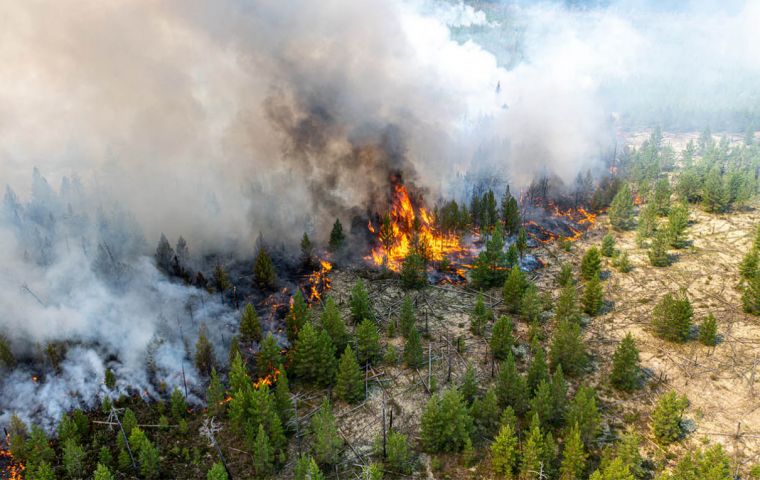MercoPress. South Atlantic News Agency
Arctic Circle wildfires carbon pollution reaches record levels, EU Earth program
 Almost all of fires are in Russia, EU's Copernicus Atmosphere Monitoring Service and the European Centre for Medium-Range Weather Forecasts jointly reported.
Almost all of fires are in Russia, EU's Copernicus Atmosphere Monitoring Service and the European Centre for Medium-Range Weather Forecasts jointly reported. This year's Arctic Circle wildfires, still ablaze, have already surpassed the record set in 2019 for CO2 emissions, adding to the carbon pollution humanity needs to curtail, the European Union's Earth observation program said on Thursday.
Uncontrolled forest fires across one of the planet's coldest regions has sent a quarter of a billion tons of CO2 spiraling into the atmosphere since January this year, topping by more than a third the total for 2019, according to satellite data. The Arctic Circle includes latitudes upwards of 66 degrees North.
Almost all of the fires are in Russia, the EU's Copernicus Atmosphere Monitoring Service (CAMS) and the European Centre for Medium-Range Weather Forecasts jointly reported.
Russia's Eastern Federal District, which includes parts of the Arctic Circle, emitted more than half a billion tons of CO2 from June to August 2020, also the highest amount to date.
“The Arctic fires burning since mid-June with high activity have already beaten 2019's record in terms of scale and intensity,” said CAMS senior scientist Mark Parrington.
While satellite images do not reveal how these fires start, many of the blazes early in the summer are thought to have been caused by “zombie” fires that smolder through the winter and then reignite, he said.
Freakishly warm weather across large swathes of Siberia since January combined with low soil moisture - likely a consequences of global warming - have fuelled the flames.
Siberia and the Arctic Circle are prone to large year-on-year temperature fluctuations, but the persistence of this year's warm spell is unusual, Carlo Buontempo, director of the EU's Copernicus Climate Change Service noted last month.
“What is worrisome is that the Arctic is warming faster than the rest of the world,” he said.
In both polar regions, average temperatures have risen more than 2 degrees Celsius since the mid-19th century, mostly in the last 50 years. That is twice the global average.


![“Working directly with President [Donald] Trump and Congress, we accomplished what no one else could,” Patel stressed](/data/cache/noticias/108417/130x80/fbi.jpg)

Top Comments
Disclaimer & comment rulesCommenting for this story is now closed.
If you have a Facebook account, become a fan and comment on our Facebook Page!